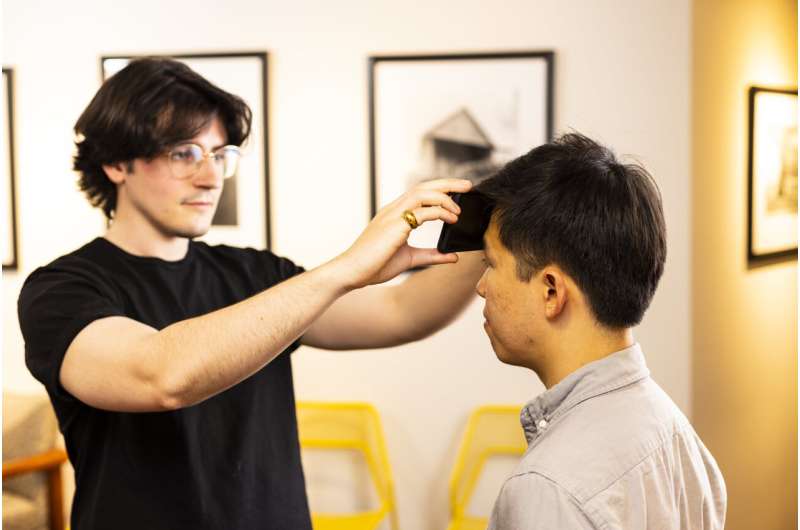This article has been reviewed according to Science X's editorial process and policies. Editors have highlighted the following attributes while ensuring the content's credibility:
fact-checked
trusted source
proofread
An app can transform smartphones into thermometers that accurately detect fevers

If you've ever thought you might be running a temperature, yet couldn't find a thermometer, you aren't alone. A fever is the most commonly cited symptom of COVID-19 and an early sign of many other viral infections. For quick diagnoses and to prevent viral spread, a temperature check can be crucial. Yet accurate at-home thermometers aren't commonplace, despite the rise of telehealth consultations.
There are a few potential reasons for that. The devices can range from $15 to $300, and many people need them only a few times a year. In times of sudden demand—such as the early days of the COVID-19 pandemic—thermometers can sell out. Many people, particularly those in under-resourced areas, can end up without a vital medical device when they need it most.
To address this issue, a team led by researchers at the University of Washington has created an app called FeverPhone, which transforms smartphones into thermometers without adding new hardware. Instead, it uses the phone's touchscreen and repurposes the existing battery temperature sensors to gather data that a machine learning model uses to estimate people's core body temperatures.
When the researchers tested FeverPhone on 37 patients in an emergency department, the app estimated core body temperatures with accuracy comparable to some consumer thermometers. The team published its findings March 28 in Proceedings of the ACM on Interactive, Mobile, Wearable and Ubiquitous Technologies.
"In undergrad, I was doing research in a lab where we wanted to show that you could use the temperature sensor in a smartphone to measure air temperature," said lead author Joseph Breda, a UW doctoral student in the Paul G. Allen School of Computer Science & Engineering. "When I came to the UW, my advisor and I wondered how we could apply a similar technique for health. We decided to measure fever in an accessible way. The primary concern with temperature isn't that it's a difficult signal to measure; it's just that people don't have thermometers."
The app is the first to use existing phone sensors and screens to estimate whether people have fevers. It needs more training data to be widely used, Breda said, but for doctors, the potential of such technology is exciting.
"People come to the ER all the time saying, 'I think I was running a fever.' And that's very different than saying 'I was running a fever,'" said Dr. Mastafa Springston, a co-author on the study and a UW clinical instructor at the Department of Emergency Medicine in the UW School of Medicine. "In a wave of influenza, for instance, people running to the ER can take five days, or even a week sometimes. So if people were to share fever results with public health agencies through the app, similar to how we signed up for COVID exposure warnings, this earlier sign could help us intervene much sooner."
Clinical-grade thermometers use tiny sensors known as thermistors to estimate body temperature. Off-the-shelf smartphones also happen to contain thermistors; they're mostly used to monitor the temperature of the battery. But the UW researchers realized they could use these sensors to track heat transfer between a person and a phone. The phone touchscreen could sense skin-to-phone contact, and the thermistors could gauge the air temperature and the rise in heat when the phone touched a body.

To test this idea, the team started by gathering data in a lab. To simulate a warm forehead, the researchers heated a plastic bag of water with a sous-vide machine and pressed phone screens against the bag. To account for variations in circumstances, such as different people using different phones, the researchers tested three phone models. They also added accessories such as a screen protector and a case and changed the pressure on the phone.
The researchers used the data from different test cases to train a machine learning model that used the complex interactions to estimate body temperature. Since the sensors are supposed to gauge the phone's battery heat, the app tracks how quickly the phone heats up and then uses the touchscreen data to account for how much of that comes from a person touching it. As they added more test cases, the researchers were able to calibrate the model to account for the variations in things such as phone accessories.
Then the team was ready to test the app on people. The researchers took FeverPhone to the UW School of Medicine's Emergency Department for a clinical trial where they compared its temperature estimates against an oral thermometer reading. They recruited 37 participants, 16 of whom had at least a mild fever.
To use FeverPhone, the participants held the phones like point-and-shoot cameras—with forefingers and thumbs touching the corner edges to reduce heat from the hands being sensed (some had the researcher hold the phone for them). Then participants pressed the touchscreen against their foreheads for about 90 seconds, which the researchers found to be the ideal time to sense body heat transferring to the phone.
Overall, FeverPhone estimated patient core body temperatures with an average error of about 0.41 degrees Fahrenheit (0.23 degrees Celsius), which is in the clinically acceptable range of 0.5 C.
The researchers have highlighted a few areas for further investigation. The study didn't include participants with severe fevers above 101.5 F (38.6 C), because these temperatures are easy to diagnose and because sweaty skin tends to confound other skin-contact thermometers, according to the team. Also, FeverPhone was tested on only three phone models. Training it to run on other smartphones, as well as devices such as smartwatches, would increase its potential for public health applications, the team said.
"We started with smartphones since they're ubiquitous and easy to get data from," Breda said. "I am already working on seeing if we can get a similar signal with a smartwatch. What's nice, because watches are much smaller, is their temperature will change more quickly. So you could imagine having a user put a Fitbit to their forehead and measure in 10 seconds whether they have a fever or not."
Shwetak Patel, a UW professor in the Allen School and the electrical and computer engineering department, was a senior author on the paper, and Alex Mariakakis, an assistant professor in the University of Toronto's computer science department, was a co-author.
More information: Joseph Breda et al, FeverPhone: Accessible Core-Body Temperature Sensing for Fever Monitoring Using Commodity Smartphones, Proceedings of the ACM on Interactive, Mobile, Wearable and Ubiquitous Technologies (2023). DOI: 10.1145/3580850




















